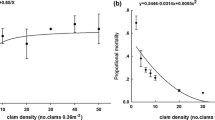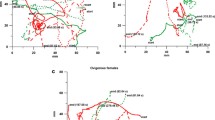Abstract
Bivalves are important grazers on phytoplankton in shallow waters. However, very little is known about their ability to capture actively moving zooplankton. We investigated the escape response and success of early and late nauplii of three copepod species (Acartia tonsa, Temora longicornis and Eurytemora affinis) in the flow field of a blue mussel, Mytilus edulis, using both video observations and incubation experiments. An empirical model was created to describe the spatial distribution of the fluid deformation rate. Nauplii responded with escape jumps at mean fluid deformation rates of 0.6–1.9 s−1. Escape success differed between taxa. T. longicornis was the poorest escaper, while A. tonsa and E. affinis were more efficient and similar to one another. Deformation rates differed in different parts of the flow field, which resulted in differences in escape success between the sectors. Nauplii were caught most often in the sector furthest away from the exhalent siphon, where the deformation rate was the weakest. There the nauplii were unable to detect an escape signal in time to react and flee.




Similar content being viewed by others
References
Batchelor GK (2000) An introduction to fluid dynamics. Cambridge University Press, Cambridge
Brooks JL, Dodson SI (1965) Predation, body size, and composition of plankton. Science 150:28–35
Cloern JE (1982) Does the benthos control phytoplankton biomass in the South Francisco Bay? Mar Ecol Prog Ser 9:191–202
Cloern JE (1991) Tidal stirring and phytoplankton bloom dynamics in an estuary. J Mar Res 49:203–221
Dame RF (1996) Bivalve filter feeders. An ecosystem approach. CRC, Boca Raton, Fla.
Davenport J, Woolmington AD (1982) A new method of monitoring ventilatory activity in mussels and its use in a study of the ventilatory patterns of Mytilus edulis (L.). J Exp Mar Biol Ecol 62:55–67
Davenport J, Smith RJJ, Packer M (2000) Mussels (Mytilus edulis L.): significant consumers and destroyers of mesozooplankton. Mar Ecol Prog Ser 198:131–137
Dolmer P (2000) Algal concentration profiles above mussel beds. J Sea Res 43:113–119
Fields DM, Yen J (1996) The escape behaviour of Pleuromamma xiphias in response to a quantifiable fluid mechanical disturbance. In: Lenz PH, Hartline DK, Purcell JE, Macmillan DL (eds) Zooplankton: sensory ecology and physiology, vol 1. Gordon and Breach, Amsterdam, pp 323–340
Fields DM, Yen J (1997) The escape behaviour of marine copepods in response to a quantifiable fluid mechanical disturbance. J Plankton Res 19:1289–1304
Haury LR, Kenyon DE, Brooks JR (1980) Experimental evaluation of the avoidance reaction of Calanus finmarchicus. J Plankton Res 2:187–202
Jack JD, Thorp JH (2000) Effects of the benthic suspension feeder Dreissena polymorpha on zooplankton in a large river. Freshw Biol 44:569–579
Jørgensen CB (1990) Bivalve filter feeding: hydrodynamics, bioenergetics, physiology and ecology. Olsen and Olsen, Fredensborg
Kiørboe T, Visser A (1999) Predator and prey perception in copepods due to hydromechanical signals. Mar Ecol Prog Ser 179:81–95
Kiørboe T, Saiz E, Visser A (1999) Hydrodynamic signal perception in the copepod Acartia tonsa. Mar Ecol Prog Ser 179:97–111
Kirk KL, Gilbert JJ (1988) Escape behaviour of Polyathra in response to artificial flow stimuli. Bull Mar Sci 53:96–105
Landry MR (1978) Predatory feeding behaviour of a marine copepod, Labidocera tripinosa. Limnol Oceanogr 23:1103–1113
Landry MR, Fagerness VL (1988) Behavioral and morphological influences on predatory interactions among marine copepods. Bull Mar Sci 43:509–529
Loo L-O, Rosenberg R (1989) Bivalve suspension-feeding dynamic and benthic–pelagic coupling in an eutrophical marine bay. J Exp Mar Biol Ecol 130:253–276
MacIsaac HJ (1996) Potential abiotic and biotic impacts of zebra mussel on the inland waters of North America. Am Zool 36:287–299
MacIsaac HJ, Sprules WG, Leach JH (1991) Ingestion of small-bodied zooplankton by zebra mussels (Dreissena polymorpha): can cannibalism on larvae influence population dynamics? Can J Fish Aquat Sci 48:2051–2060
Meadows PS, Meadows A, West FJC, Shand PS, Shaikh MA (1998) Mussels and mussel beds (Mytilus edulis) as stabilizers of sedimentary environments in the intertidal zone. Spec Publ Geol Soc Lond 139:331–347
Møhlenberg F (1995) Regulating mechanisms of phytoplankton growth and biomass in a shallow estuary. Ophelia 42:229–256
Ohman MD (1988) Behavioral responses of zooplankton to predation. Bull Mar Sci 43:530–550
Pace ML, Findlay SEG, Fischer D (1998) Effects of an invasive bivalve on the zooplankton community of the Hudson River. Freshw Biol 39:103–116
Riisgård HU, Møhlenberg F (1979) An improved automatic recording apparatus for determining the filtration rate of Mytilus edulis as a function of size and algal concentration. Mar Biol 52:61–67
Singarajah KV (1969) Escape reactions of zooplankton: the avoidance of a pursuing siphon tube. J Exp Mar Biol Ecol 3:171–178
Strickler JR (1977) Observation of swimming performances of planktonic copepods. Limnol Oceanogr 22:165–169
Strickler JR, Bal AK (1973) Setae of the first antennae of the copepod Cyclops scrutifer (Sars): their structure and importance. Proc Natl Acad Sci USA 70:2656–2659
Titelman J (2001) Swimming and escape behaviour of copepod nauplii: implications for predator–prey interactions among copepods. Mar Ecol Prog Ser 213:203–213
Titelman J, Kiørboe T (2003a) Motility of copepod nauplii and implications for food encounter. Mar Ecol Prog Ser (in press)
Titelman J, Kiørboe T (2003b) Predator avoidance by nauplii. Mar Ecol Prog Ser (in press)
Viitasalo M, Kiørboe T, Flinkman J, Pedersen LW, Visser AW (1998) Predation vulnerability of planktonic copepods: consequences of predator foraging strategies and prey sensory abilities. Mar Ecol Prog Ser 175:129–142
Wong CK (1996) Responses of copepods to hydromechanical stimuli. Crustaceana 69:853–859
Yen J, Fields DM (1992) Escape responses of Acartia hudsonica (Copepoda) nauplii from the flow field of Temora longicornis (Copepoda). Arch Hydrobiol Beih Ergebn Limnol 36:123–134
Yen J, Strickler JR (1996) Advertisement and concealment in the plankton: what makes a copepod hydrodynamically conspicuous? Invertebr Biol 115:191–205
Yen J, Lenz PH, Gassie DV, Hartline DK (1992) Mechanoreception in marine copepods: electrophysiological studies on the first antennae. J Plankton Res 14:495–512
Acknowledgements
This study was financed by grants from NorFa, the Walter and Andrée de Nottbeck Foundation and the Academy of Finland to S.G. and a EU-TMR Marie Curie PhD Fellowship (ERBFMBICT 971833) to J.T. We are grateful to J. Melby for giving practical advice in the laboratory, H. Jacobsen for helping in managing the data, E. Pedersen for constructing devices for the laboratory work and M. Viitasalo for helpful comments on earlier drafts of the manuscript.
Author information
Authors and Affiliations
Corresponding author
Additional information
Communicated by L. Hagerman, Helsingør
Rights and permissions
About this article
Cite this article
Green, S., Visser, A.W., Titelman, J. et al. Escape responses of copepod nauplii in the flow field of the blue mussel, Mytilus edulis . Marine Biology 142, 727–733 (2003). https://doi.org/10.1007/s00227-002-0996-1
Received:
Accepted:
Published:
Issue Date:
DOI: https://doi.org/10.1007/s00227-002-0996-1




